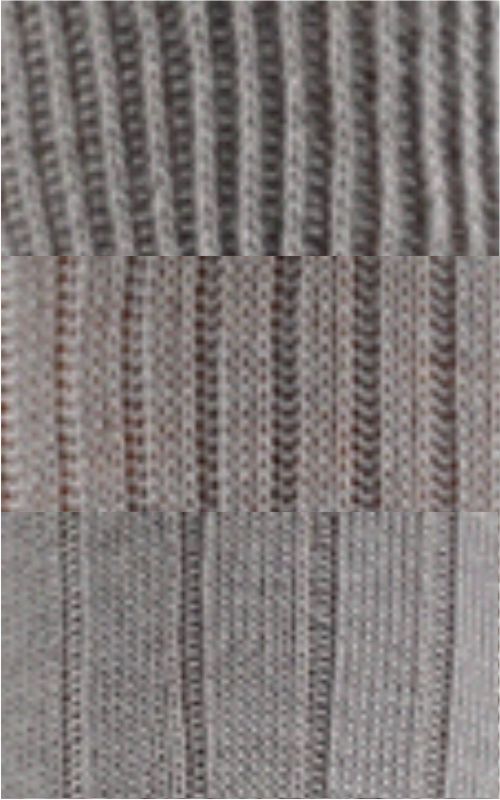Influence of structural and constructional parameters of knitted fabrics on the thermal properties of men's socks Original scientific paper
Main Article Content
Abstract
The research is focused on determining the influence of structural and constructional parameters of rib knitted fabrics on the thermal properties of men's socks. Men's socks are made in three different pattern constructions of three types of basic yarns: bamboo, cotton and a cotton/polyester blend with the additional filament polyamide yarn and wrapped rubber wire for the so-called render socks. For all analyzed sock rib patterns, the most important structural parameters of the yarn and construction parameters of the knitted fabrics were determined. Thermal properties of socks such as the cool touch feeling property, thermal conductivity, heat retention coefficient and thermal resistance were determined by using Thermal Labo and Thermal Mannequin measuring devices. The structural and constructional parameters of knitted fabrics were shown to affect the investigated thermal properties of the socks, making them more or less insulating or heat conducting. Values of the warm-cold feeling parameter as well as thermal conductivity vary depending on the construction pattern, showing a decrease as the number of face loops is increased i.e. in the sequence R1:1> R3:1> R7:1. The ability to retain heat decreases in the opposite sequence R7:1 > R3:1 > R1:1. The highest values of heat retention were determined for R7:1 rib knitted socks by both methods. A regression equation has been established with thickness, loop length, mass per unit area and porosity as independent variables, and thermal resistance (determined by the Thermo Labo method) as the dependent variable. The loop length and mass per unit area were shown to contribute significantly to the model.
Article Details
Issue
Section

This work is licensed under a Creative Commons Attribution-NonCommercial-NoDerivatives 4.0 International License.
Authors who publish with this journal agree to the following terms:
Authors retain copyright and grant the journal right of first publication with the work simultaneously licensed under a Creative Commons Attribution License that allows others to share the work with an acknowledgement of the work's authorship and initial publication in this journal.
Authors grant to the Publisher the following rights to the manuscript, including any supplemental material, and any parts, extracts or elements thereof:
- the right to reproduce and distribute the Manuscript in printed form, including print-on-demand;
- the right to produce prepublications, reprints, and special editions of the Manuscript;
- the right to translate the Manuscript into other languages;
- the right to reproduce the Manuscript using photomechanical or similar means including, but not limited to photocopy, and the right to distribute these reproductions;
- the right to reproduce and distribute the Manuscript electronically or optically on any and all data carriers or storage media – especially in machine readable/digitalized form on data carriers such as hard drive, CD-Rom, DVD, Blu-ray Disc (BD), Mini-Disk, data tape – and the right to reproduce and distribute the Article via these data carriers;
- the right to store the Manuscript in databases, including online databases, and the right of transmission of the Manuscript in all technical systems and modes;
- the right to make the Manuscript available to the public or to closed user groups on individual demand, for use on monitors or other readers (including e-books), and in printable form for the user, either via the internet, other online services, or via internal or external networks.
How to Cite
References
Abd El-Hady RAM. Investigation of the Thermal Properties and Anti-microbial Behavior of Socks Knitted from Conductive Yarns, Asian J Text. 2014; 4: 1-17. https://dx.doi.org/10.3923/ajt.2014.1.17
Akaydin M, Can Y. A Research of Strength Properties of Socks Knitted from New Cellulose-Based Fibers, Electron J Text Technol. 2012; 6: 28-36. http://acikerisim.pau.edu.tr:8080/xmlui/handle/11499/6490
Kandi I, Nath Das K, Mahish SS. Thermo-Physiological Comfort Properties of P/B Blended Suiting Fabrics, Int J Innov Res Technol Sci Eng. 2013; 2: 7620-7629. https://www.ijirset.com/upload/2013/december/68_Thermo.pdf.
Onofrei Е, Rocha АМ, Catarino А. The Influence of Knitted Fabrics’ Structure on the Thermal and Moisture Management Properties, J Eng Fibers Fabr. 2011; 6: 10-22. https://doi.org/10.1177/155892501100600403
Tesinova P, Atalie D. Thermal Comfort Properties of Sport Fabrics with Dependency on Structure Parameters and Maintenance, Fibers Polym. 2022; 23: 1150-1160. https://doi.10.1007/s12221-022-4160-x
Mishra R, Jamshaid H, Yosfani SHS, Hussain U, Nadeem M, Petru M, Tichy M, Muller M. Thermo physiological comfort of single jersey knitted fabric derivatives, Fashion Text. 2021; 40: 1-22. https://doi.org/10.1186/s40691-021-00266-5
Mansoor T, Hes L, Bajzik V. A new approach for thermal resistance prediction of different composition plain socks in wet state (part 2), Autex Res J. 2021; 21: 238-247. https://dx.doi.org/10.2478/aut-2019-0070
Bivainyte A, Mikucioniene D, Kerpauskas P. Investigation on Thermal Properties of Double-Layered Weft Knitted Fabrics, Mater Sci. 2012; 18: 167-171. https://dx.doi.org/10.5755/j01.ms.18.2.1921
Pavlović Ž, Vrljičak Z. Comparing double jersey knitted fabrics made of Tencel and modal yarns spun by different spinning methods, J Eng Fibers Fabr. 2020; 15: 1–15. https://dx.doi.org/10.1177/1558925020919854
Trajković SD, Tasić SP, Stepanović MJ, Šarac IT, Radmanovac MN. Physiological characteristics of the socks made from bamboo and conventional fibers, Adv Technol. 2014; 3: 59-65. https://dx.doi.org/10.5937/savteh1401059T
Pan N., Gibson P., Thermal and Moisture Transport in Fibrous Materials, 1st Edition, The Textile Institute, 2006 https://doi.org/10.1201/9781439824351
Kulacki F.A., Handbook of Thermal Science and Engineering, Publisher Springer Cham, 2020 https://doi.org/10.1007/978-3-319-32003-8
Angelova, R.A., Textiles and Human Thermophysiological Comfort in the Indoor Environment, 1st Edition, CRC Press, 2017 https://doi.org/10.1201/b19118
Aboalasaad ARR, Sirkova BK, Tesinova P, Khali A. Guidelines for measuring thermal resistance on thermal Foot Manikin, Mater Today: Proc. 2020; 31: S232–S235. https://dx.doi.org/10.1016/j.matpr.2019.11.068
Mansoor T, Hes L, Bajzik V, Noman MT. Novel method on thermal resistance prediction and thermo-physiological comfort of socks in a wet state, Text Res J. 2020; 90: 1987–2006. https://dx.doi.org/10.1177/0040517520902540
Cimilli S, Nergis BU, Candan C, Ozdemir M. A Comparative Study of Some Comfort-related Properties of Socks of Different Fiber Types, Text Res J. 2010; 80: 948–957. https://dx.doi.org/10.1177/0040517509349782





